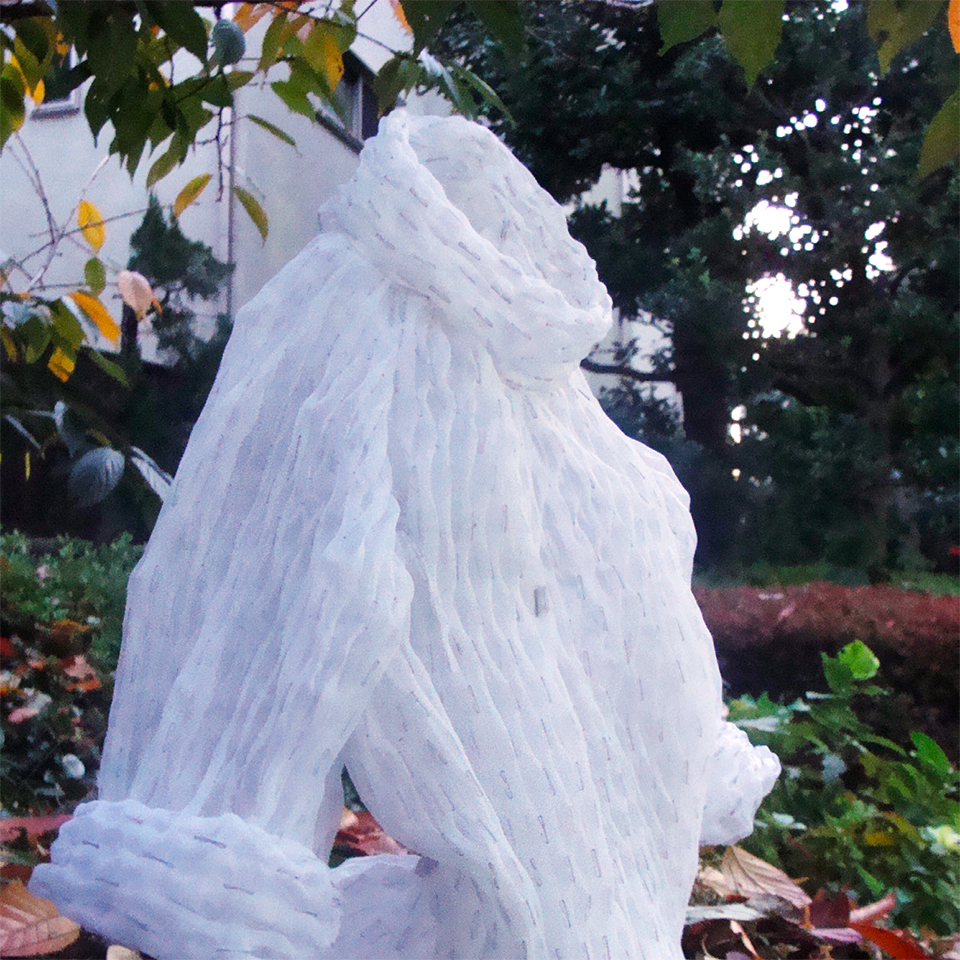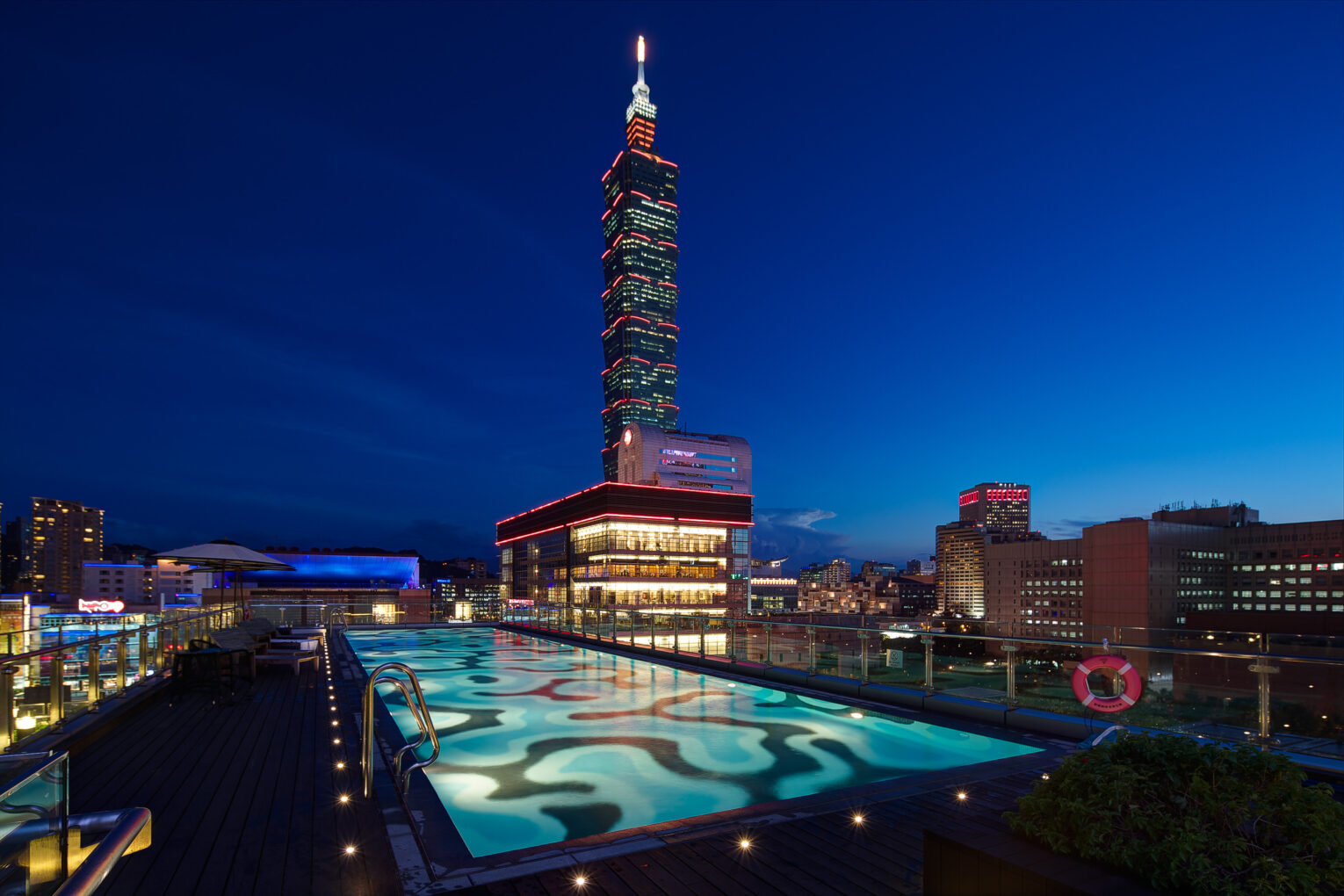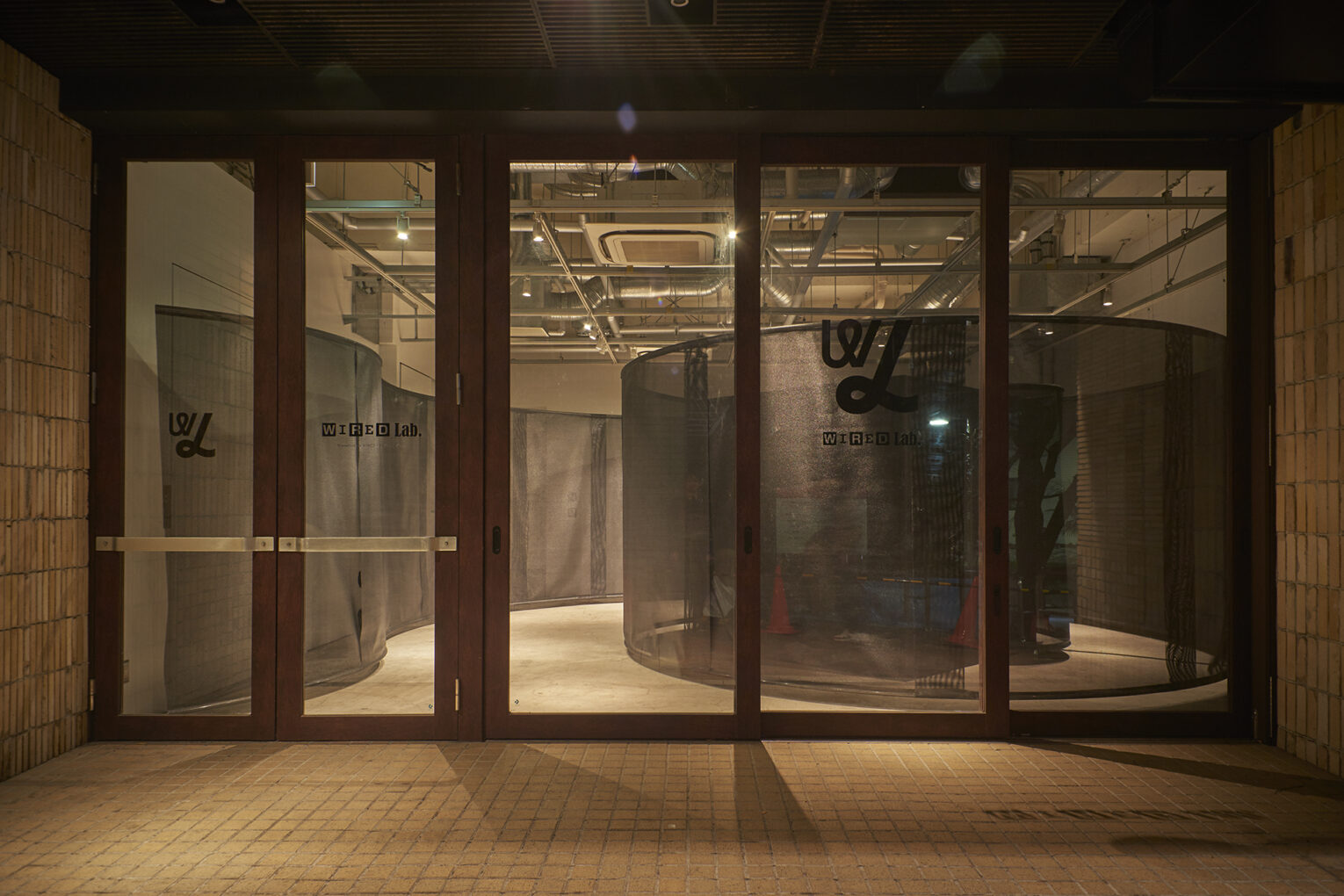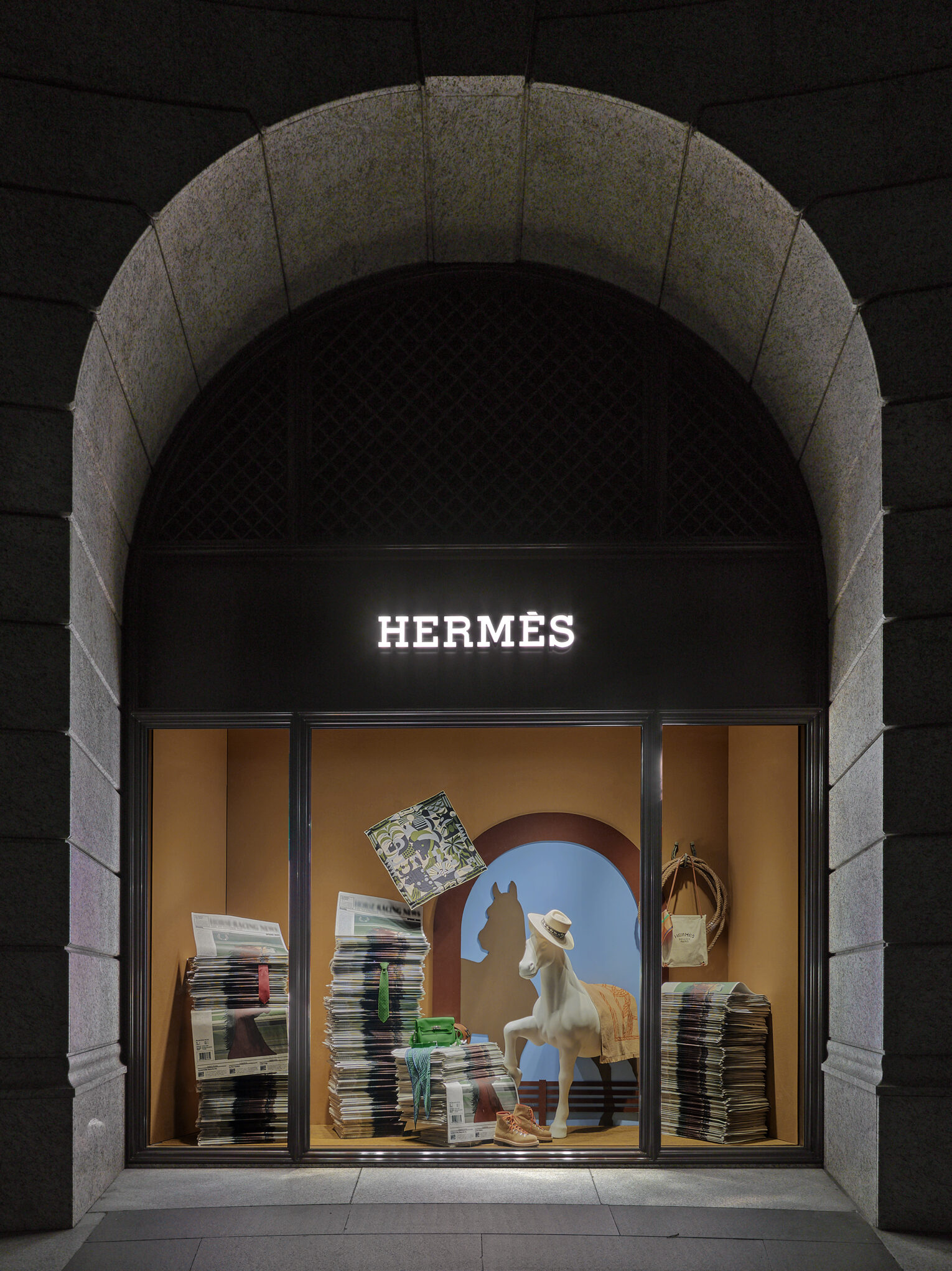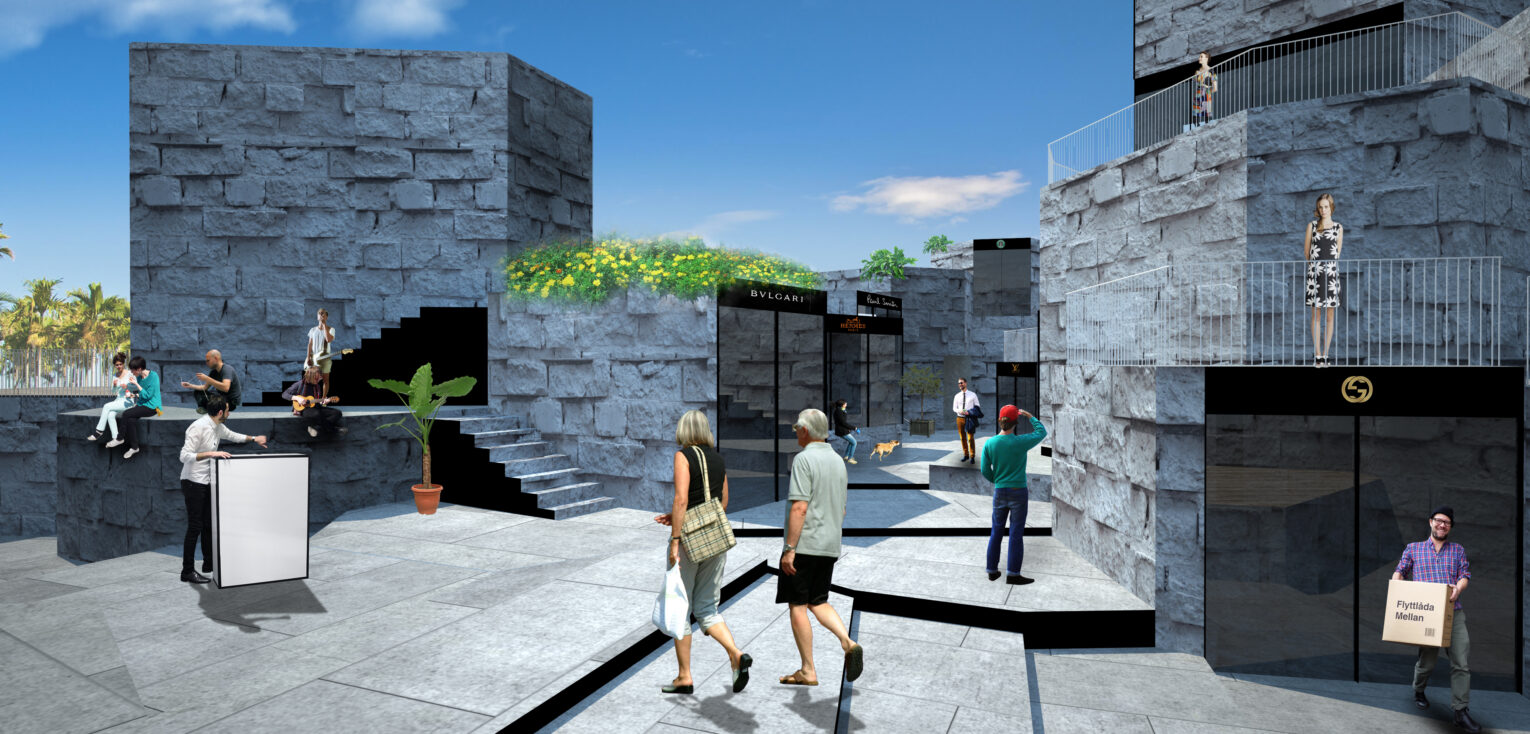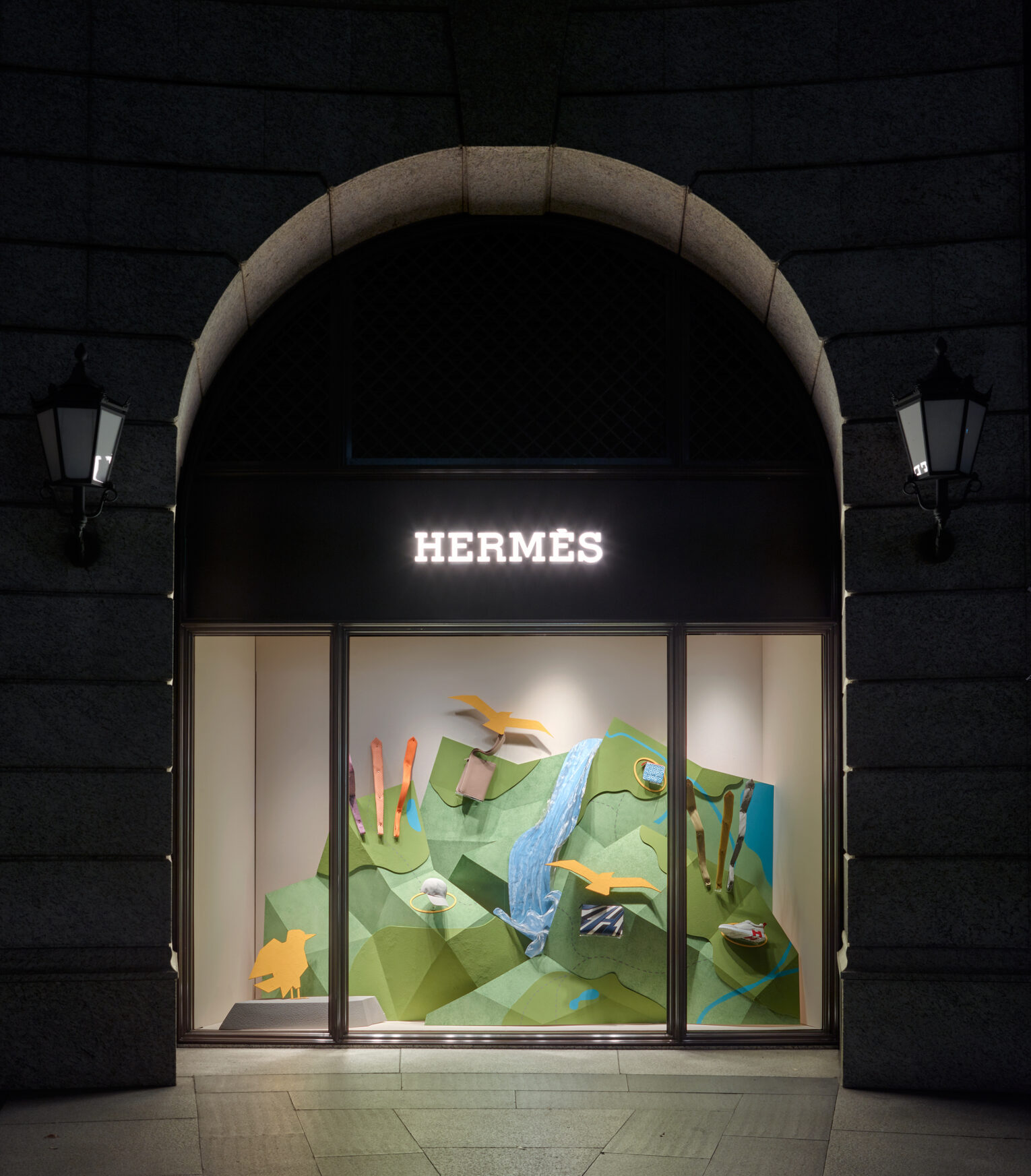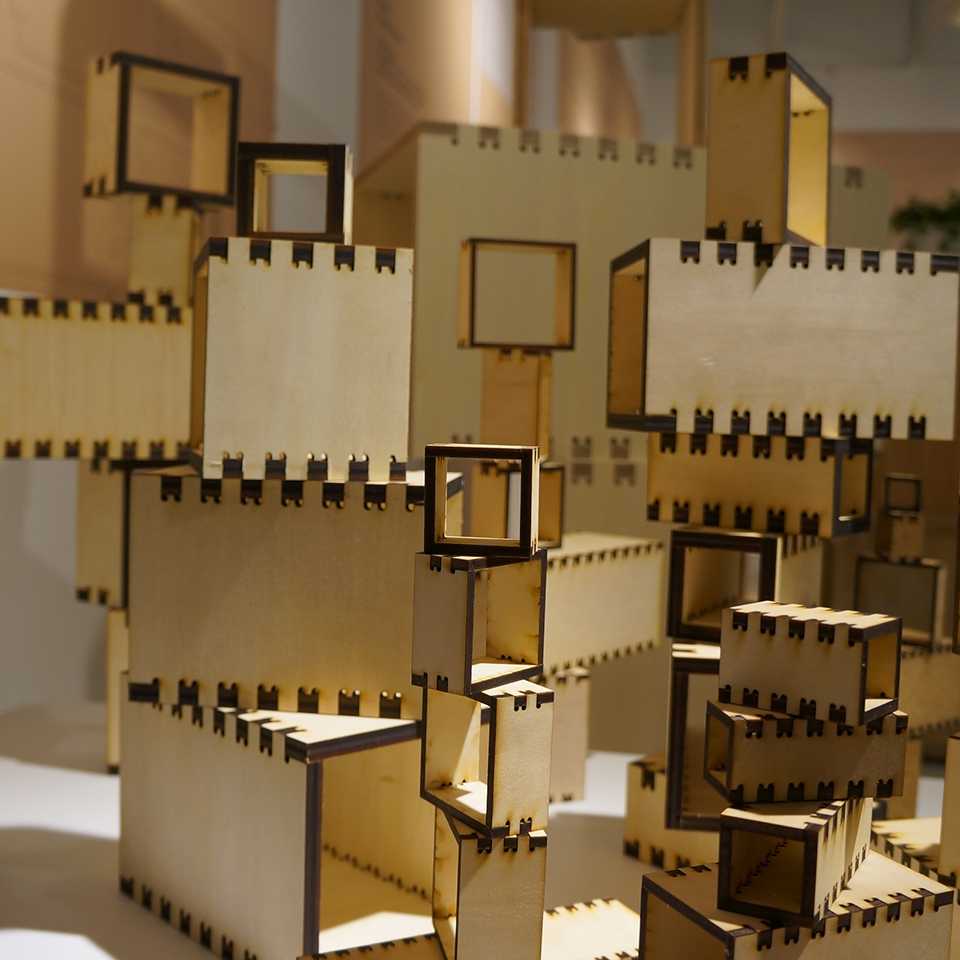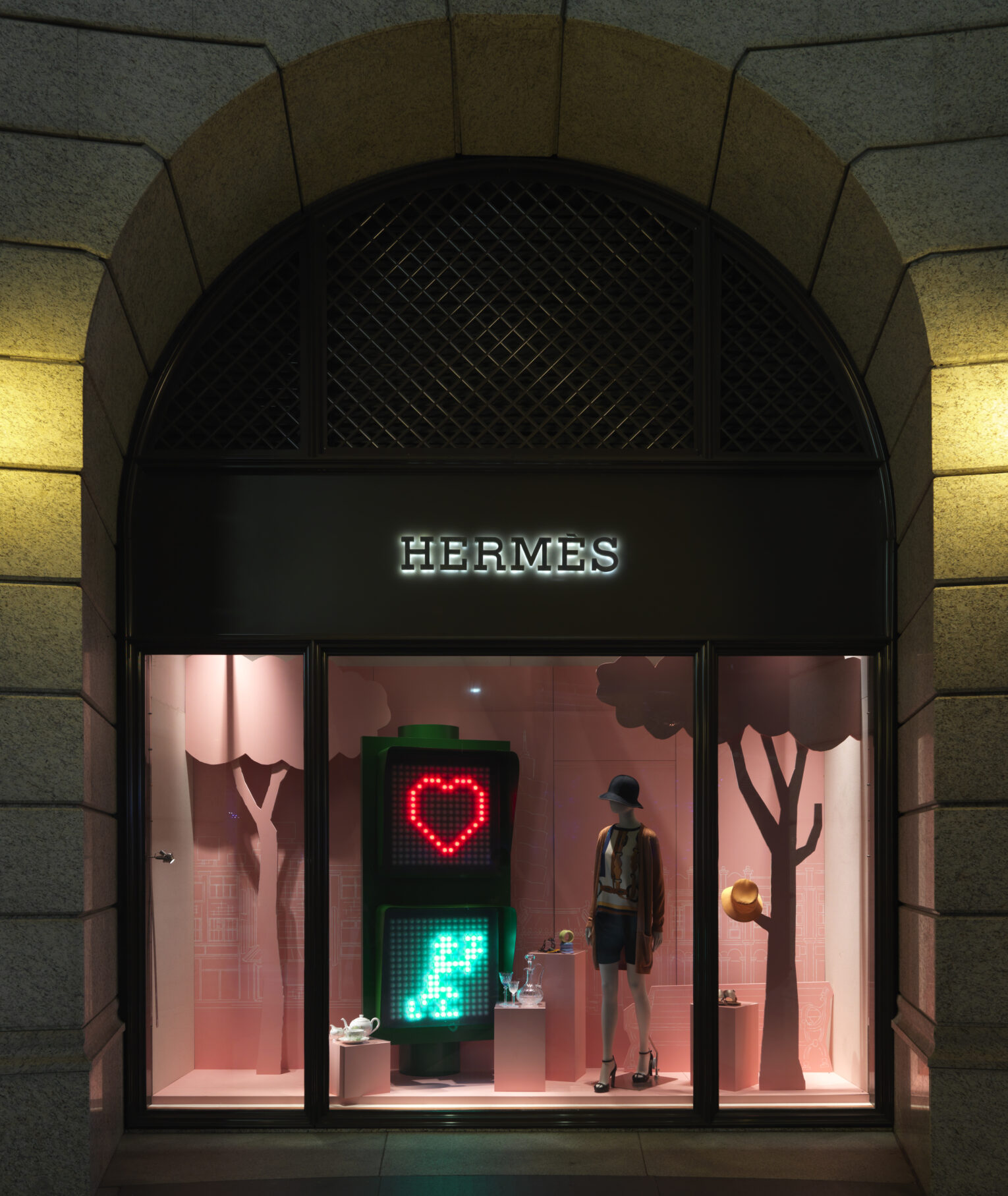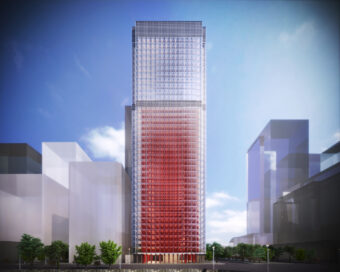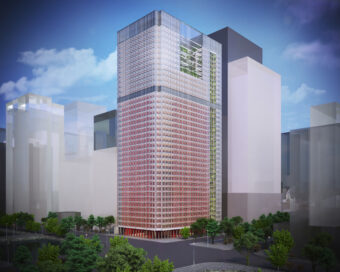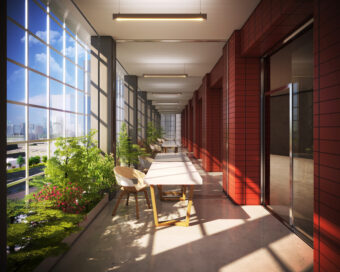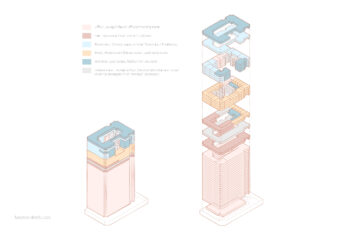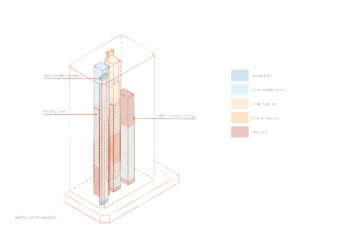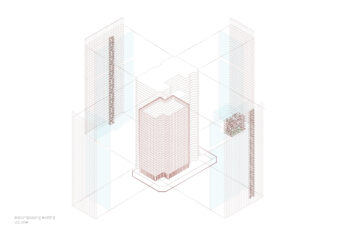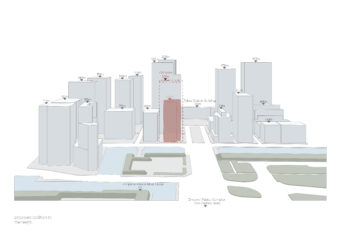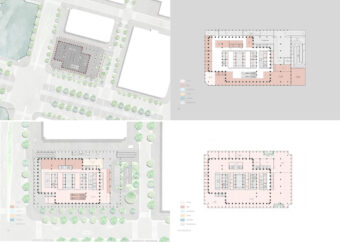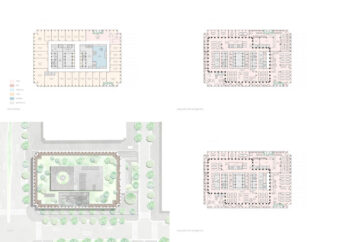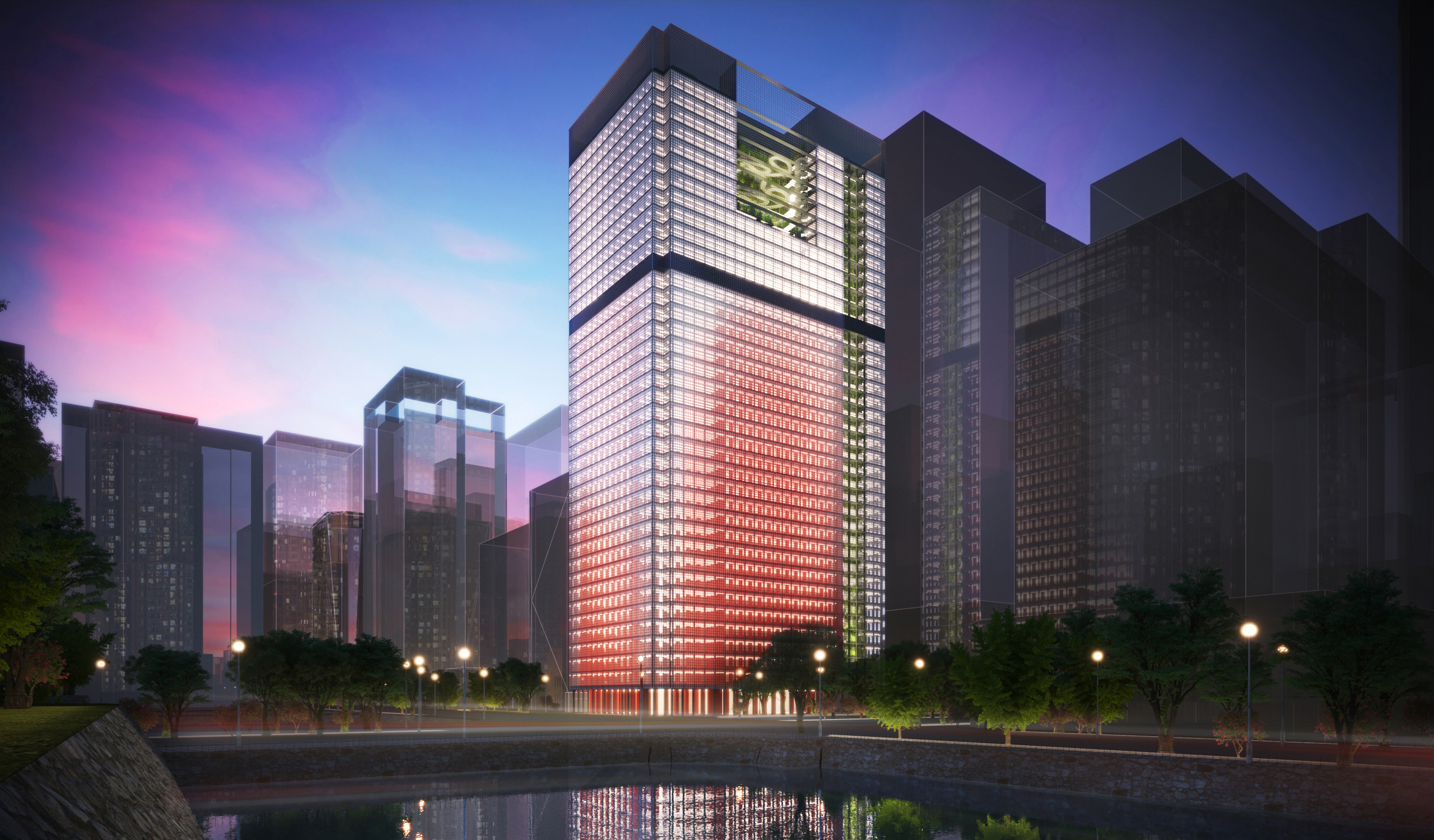
東京海上日動本社ビル 増築改修提案 Tokio Marine Nichido Headquarters Building Renovation
東京海上日動ビル本館は東京の心臓部、皇居正面の角地に立地する、独特の美しさと歴史的な価値を兼ね備えた、東京を代表する超高層建築です。日本の近代建築のパイオニアであり、多くモダニズムの傑作を生み出した前川國男の設計によるこの建築は、日本では最初期の超高層ビルの一つです。設計当時周辺に高層建築が全くない中で、周囲に際立って高くそびえるその計画は皇居に対する不敬であるとの批判の的となり、工事開始の直前に計画高さの1/3が削減されるという特異な経緯でも知られています。近年の規制緩和で大手町や丸の内界隈の建築の高さや容積制限は大きく引き上げられ、現在では周辺の建物は東京海上日動ビルよりはるかに高く聳えるようになっています。ただし、この建築の評価は歴史的経緯だけにあるわけではありません。粗々しい質感に富んだ赤いレンガタイル、垂直の柱と窓による彫りの深い構成とリズミカルに刻まれる影、雁行状に分節されたボリュームなど、周辺の画一的な近年の建築群とは好対照を示しながら、お堀端の深い緑とも相まった独特の存在感を示しています。歴史的な観点からも美的な観点からも、保存されるべきランドマークであることに疑問の余地はありません。
2021年、東京海上日動ビルの建物の解体と再開発による新築計画が発表されました。このような決定の背景には、東京の超一等地にもかかわらず現状で容積や高さが十分に活用されておらず、機械や空調などの設備やセキュリティなども現代のビジネススタンダードに適合していないなど多くの要素があり、ビジネス視点での再開発という判断の正当性は十分に理解できます。それでもNOIZとして、建築を通して社会的価値提示を行う立場と責任とから、東京海上日動ビルの文化的、歴史的価値を残しつつ、同時に新しい時代の環境視点やテクノロジー活用の可能性を積極的に取り込んだ、次世代の再開発の在り方を社会へと問いかけたいと考えました。建築史的な保存という視点を超えて、環境負荷的な視点からもこれ以上スクラップ・アンド・ビルドを、短期の投資的視点だけを根拠に無批判に肯定し続けるわけにはいきません。そのためには、建築家の側から率先して新たな保存改修や機能付加、再開発に見合う再価値化の具体的な手法やデザインを提示していく姿勢が重要になると、わたしたちNOIZは考えます。
今回の保存改修計画で重視したのは、オリジナルの美的および歴史的な価値を残すことはもちろん、この立地で建設可能な容積や高さも最大限に確保し、最新のオフィスビルの環境性能や機能性も新たに付加することで、文化財としての価値とビジネス価値、矛盾しがちな二つの要求をいずれも満たすという点です。その実現のために導入したのが、既存のタワーを新しいガラスの外皮で「巻き取る」という手法です。伝統的な和菓子である葛饅頭の、透明な葛の外皮が濃厚な餡を包み込む構成のように、透明な新しい外皮が既存の重厚なタワーを包みこみ、新たな二重構造を構成することで次世代の要求に対応します。新しい外皮は遮熱や断熱、開放的な視界の確保など、基本的な性能や価値の向上を担うと同時に構造的な補強も行い、赤いレンガ色の既存タワーのデザインは、透明な外皮を通して、新しい質感を内堀越しの開けた都市景観上に浮かび上がらせます。付加された外皮により拡張された容積には、新しい機能をサポートする垂直動線や設備のコアが追加挿入され、さらに上部にはオリジナル案で計画されていた高さまで床の積み増しを行うことで、延床面積はほぼ3倍になります。内部空間にそのまま残される既存躯体の彫りの深い構成と仕上げが、均質で冗長になりがちなオフィススペースに独特のリズムと質感、歴史との接続の感覚、さらには利用者にプライドの感覚をももたらします。経済的にも機能的にも新しい価値を付加しながら古い構造を再価値化し、環境負荷を低減するこうしたアプローチは、アメリカやヨーロッパの大都市でも近年積極的に活用され、街に歴史の厚みと多様性をもたらし、新しい活性化に大きく寄与しています。日本でも法制度や不動産評価のしくみの改正により、今後は同様のアプローチが実践されていくべきです。
本提案にはレトロフィットの可能性だけでなく、COVID-19のパンデミックにより加速した社会の職や住に関する新しい流れや、デジタル技術の進展がもたらす離散化や流動化の傾向など、次世代の超高層ビルが求められることになる独自の構成や構造も積極的に取り込んでいます。これからの超高層ビルでは、従来型の特徴であるメガフロアと集中セキュリティポイントによるマス管理等の固定的な要求にも相応にも対応しつつ、より細分化され多様な要素が混在するニーズをフレキシブルに制御する、ハードとソフトが一体となったあたらしい都市基盤としての構造が求められるようになります。本提案ではホテルエリアとサービス・アパートメントは需要に応じた互換性を持ち、同時にそれらのラウンジはオフィスエリアの拡張的な会議やワークラウンジとしても活用可能で、また逆にオフィスのファシリティの一部は居住や滞在する人にもシェアできるようになっています。さらには建物や都市の境界を越えた流動性の担保を念頭に、例えば郊外やリゾート、海外との広域ネットワークの一部としての受け皿機能を前提とした構成、ネットワークベースの学校の受け入れ機能なども、これからの大規模都市施設には不可欠な要素として組み込んでいます。中間階や高層部に挿入された広場や公園、人以外のエージェント専用の垂直動線を前提とした動線なども、従来のオフィスビルとは異なる広範な対応性を前提とした、社会的持続性の受け皿としての新たな機能です。
なかでも特徴的なシステムの一例に、外壁に組み込まれた垂直の半屋外シャフト、グリーンシャフトが挙げられます。これは各層に自然換気とグリーンな景観を提供すると同時に、ドローン専用の独立した軽物流動線およびランディング施設としても機能する、新しいインフラ要素です。ドローンとシャフトによる人の移動を伴わない垂直動線は、現行のエレベーターのみに頼るシステムでは不可避な人や物の無駄な移動や時間集中リスクを低減し、床の有効利用や人流および物流の全体最適化を実現しつつ、同時に各利用者の個別最適の実現にも貢献します。これらのシステムが小売店舗を兼ねたローカルロジスティクスとも連携し、よりマクロなニーズの予測や個々の利用者の嗜好にもフレキシブルに対応しながら、フードロスの最小化なども可能にしていきます。
今回ノイズとして提示している自主提案は、東京海上日動ビル単体の問題にはとどまりません。ここで提示されているのは、近年軒並み老朽化問題が顕在化しつつある、高度成長期の建築群一般に共通する問題で、その状況全体に対する一つのマニフェストでもあります。それはすなわち、20世紀的なスクラップビルドを前提としたアプローチに代わる、次世代の社会的責任のあり方や姿勢に関するパラダイムシフトの可視化であり、建築設計者としての提案です。既存建築物の保存というと、いわゆる腰巻外壁保存方式以外の手法がなかなか提示されない現状において、建物の歴史的、文化的な誇りを維持しつつ、現代的な都市的プレゼンスを付与する具体的な可能性の提示を試みています。既に再建計画が公式に発表されている中で、東京海上日動ビル本館という社会遺産を保存することは、現実にはもう難しいかもしれません。それでもあえてこうした提案を社会へと投げかけることで、今後生じる類似したケースにおいて、より拡張的なアプローチと新しい可能性が考慮され、持続的な形で社会的な価値が増幅されるような開発の事例が、一つでも実現することを期待しています。
Tokio Marine Nichido Headquarters Building (TMN) is an epoch skyscraper in the heart of Tokyo, right at the corner of the Imperial Palace. It was designed in the 70s by Kunio Maekawa – a pioneer of modernist architecture in Japan, author of many architectural masterpieces. TMN Building is one of the first skyscrapers in Tokyo. The building is also known for the fact that it once became a hot subject of debate for its original height towering over the Imperial Palace, which resulted the building to a last-moment reduction of a ⅓ of its height. Later the height limits of the area had loosened and the surrounding buildings started soaring much higher after 2000. Now TMN building is very distinguishable from its neighbors not only due to its reduced height, but also because of outstanding aesthetics. Its rich, thick, red brick-ish tiles and deep cuts of vertical windows contrast with a sleek look of its neighbors covered by shiny glass curtain walls. From a historical standpoint this masterpiece undoubtedly shall be preserved as a landmark of the area.
However, the developer has recently announced a new plan for this plot that involves demolishing the existing TMN building. The reasons behind such decision are current significant under-utilization of total buildable floor area and the height limit, and outdated MEP equipment. Even though from a business standpoint the decision is justified, architects raise their voices to preserve the existing building due to its cultural importance and historical value. Also, the fact that a simple scrap-and-build approach being no more reasonable for today adds a good reason for reconsideration from an environmental point of view. But the plan is still proceeding unaffected.
Therefore, NOIZ took on a task to present a design that allows both to preserve the masterpiece and to comply with the most up-to-date office building standards. The solution we propose is a “wrapping by a new building” around the existing tower. One of the traditional Japanese sweets, called “kuzu-manju”, is a great visual metaphor for this concept. A crystal clear mochi-skin surrounds dark and thick bean paste, showing dual-layered structure in a very beautiful fashion. Just like “kuzu-manju”, NOIZ envisioned an extra layer of glass wrapping around the existing building, to improve its efficiency and performance, while simultaneously keeping the beauty of the existing building visible to the spectators. The space between the new and old perimeter can accommodate reinforcement and extra vertical cores, which allow the entire building to be raised almost to the height of its neighbors. The total floor area can be almost tripled. Wrapping skin also improves the environmental standards in terms of heat insulation, sunlight cut, visibility, view, and updated MEP structure. The existing structure’s finishes remain intact inside of the new shell to bring rhythms and a vivid sense of materiality to the interiors. Such design can be a triumphal symbol of utilizing old structure, while bringing new value.
In terms of functionality the project showcases a new approach towards urban office by mixing multiple functions in a dispersed manner. Triggered by the COVID-19 pandemic, the new shift towards remote working is becoming a new standard and it is unlikely to go back to the good old 9-5 work style. Office buildings need to have a more robust offer of facilities and be more flexible, updating their composition and circulation. In our proposal, hospitality service, residences and work spaces coexist sharing resources and facilities. The plan allows portions of the hotel area can work as service apartments or meeting lounges and vice versa. Aside from traditional functions, buildings for new normal should also allow for more exploratory functions like e.g. a network-based school system. In such a system students can choose a campus from a variety of small venues in mixed-use buildings like the presented one, or in suburb, or even in nature.
The building also contains some new features for a new building standard, such as green shaft vertically going through on the new skin, which provide natural heat circulation and visible green for residents/neighbors, as well as a secured infrastructure for drone delivery/pick-up for light weight parcels to reduce unnecessary operation of heavy-load elevators. Those green shaft networks among ground floor, landing spots provided on middle floors, and sky gardens to provide amenity and additional value to the residents and workers.
Presented proposal intends to resolve an emerging issue of how to preserve remarkable mid-late 20th century buildings that do not comply with recent standards, yet remain symbols of their era and the area. Recently, such cases are becoming more and more common and leading big debates, especially in Japan which experienced rapid economic growth in 1960’s and 70’s. Our solution touches upon environmental, business, value, equipment and circulation issues as well as applying new technology. We also tackle the aesthetic aspect of such renovations by adding a new value, while maintaining original looks intact to let the building remain a historical pride. It might be too late to save the legacy of Tokio Marine Nichido Headquarters Building as the rebuilding plan has been officially announced, but we are hoping that an approach similar to the one presented can be implemented in other cases. Such treatment can become one of the feasible methodologies letting renovations give more respect to the global issue of sustainability, while providing access to a new technology standard.
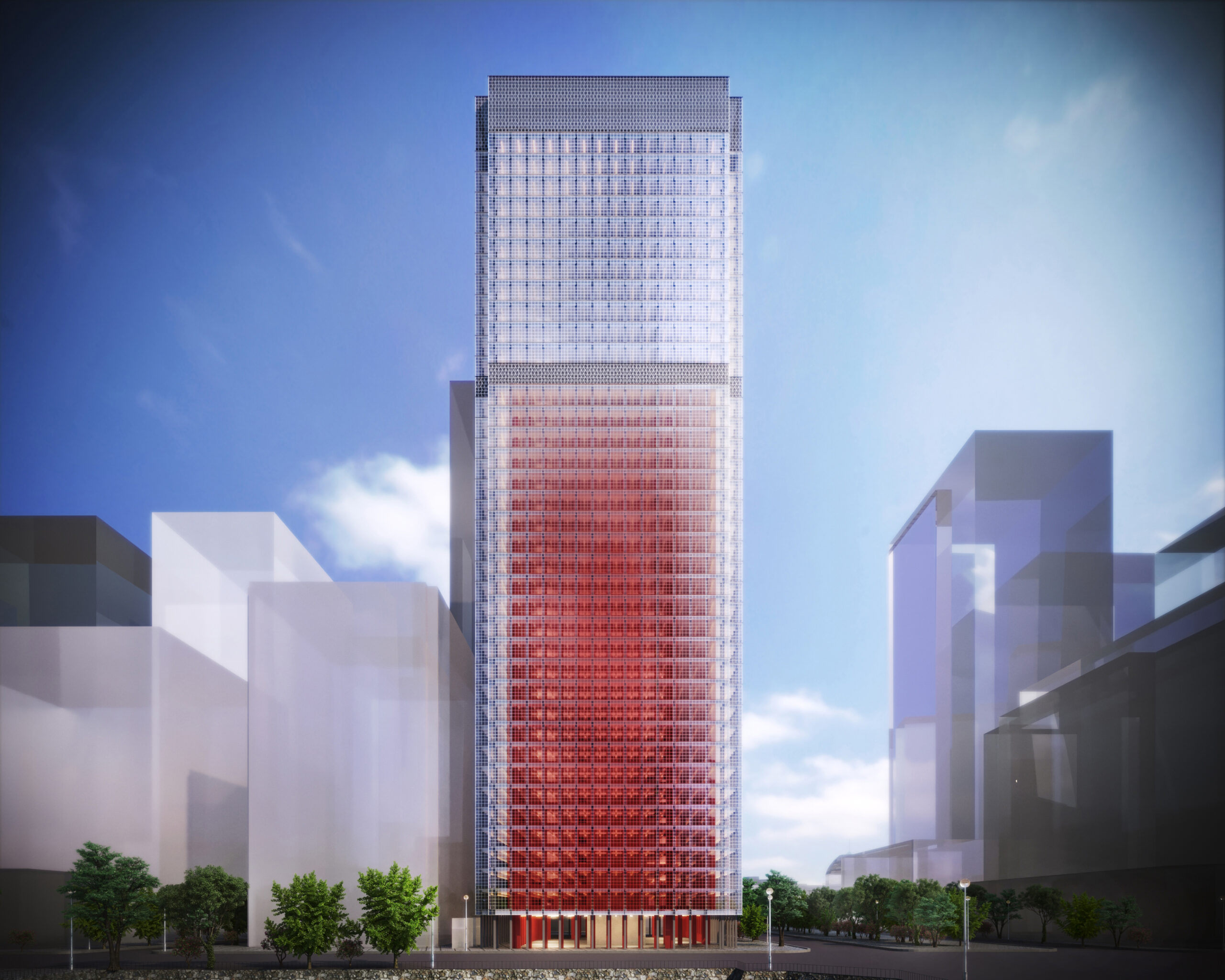
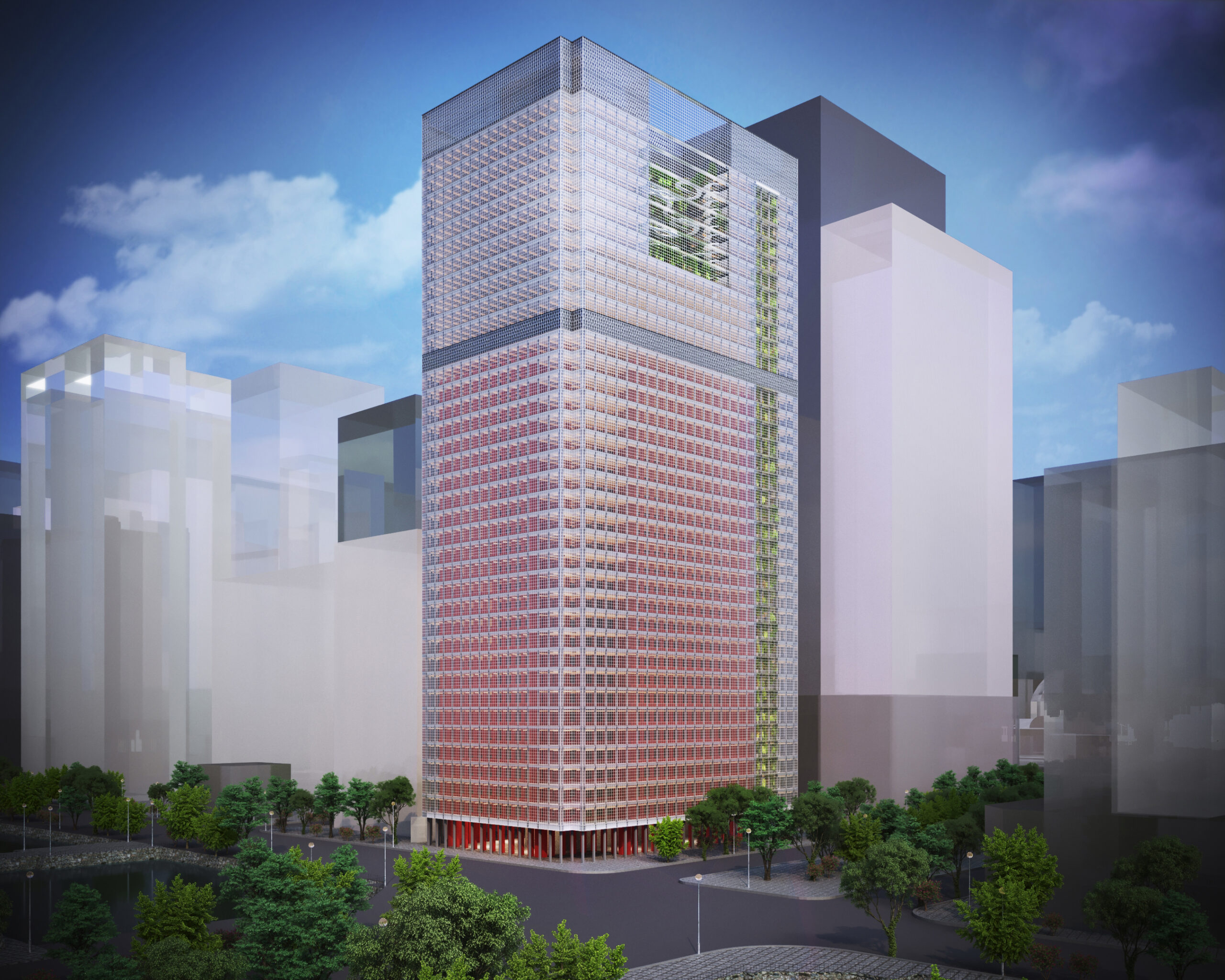
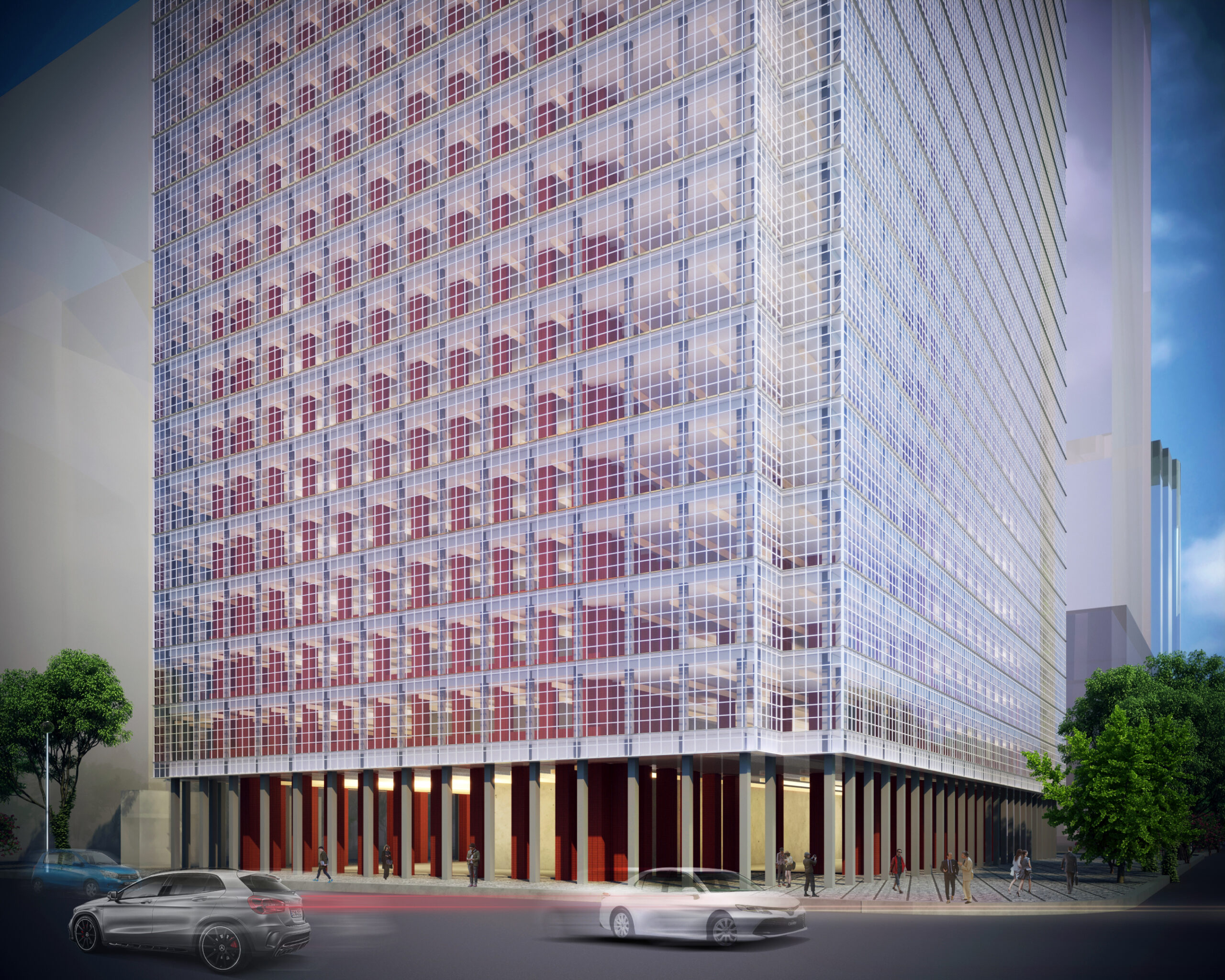
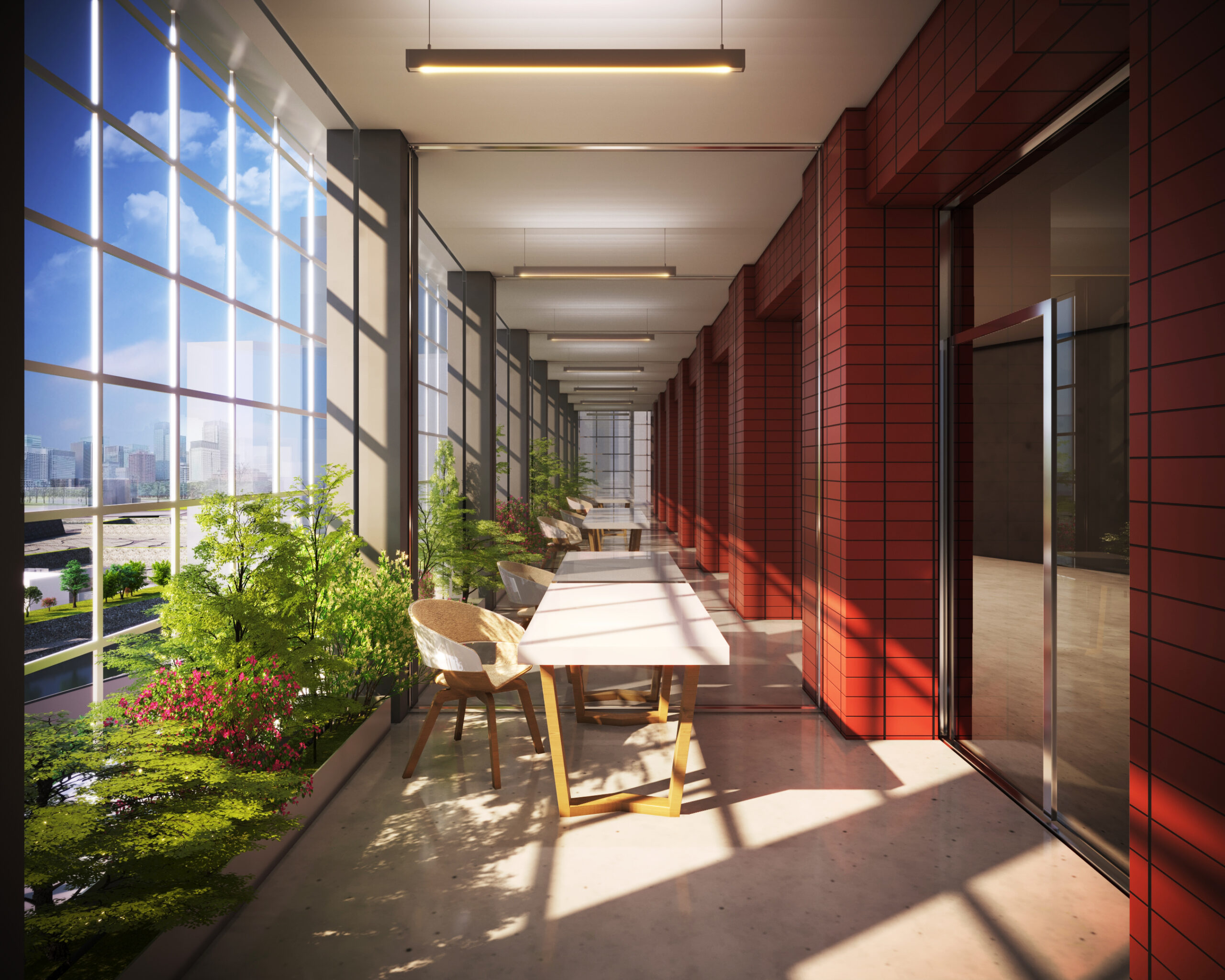

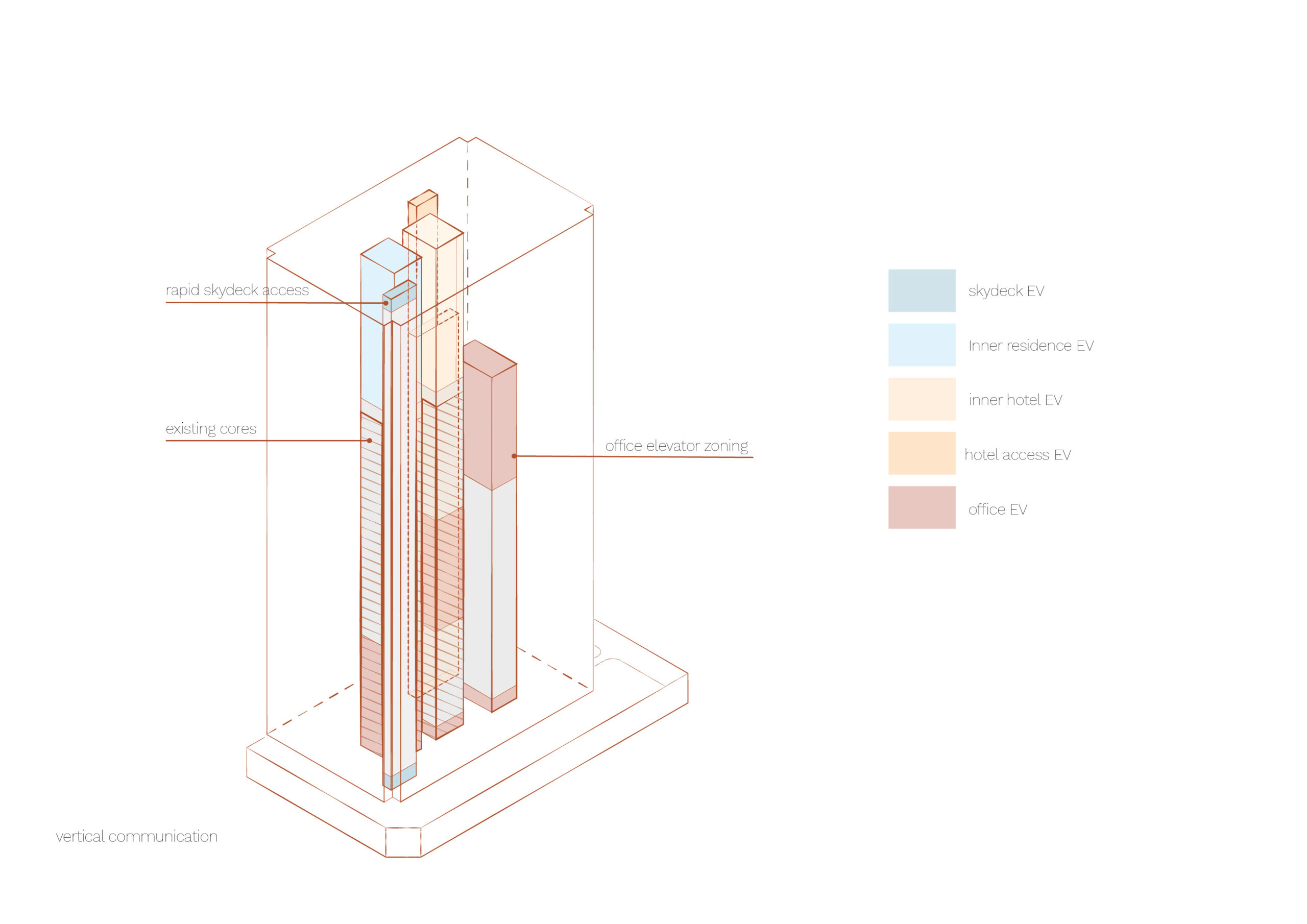
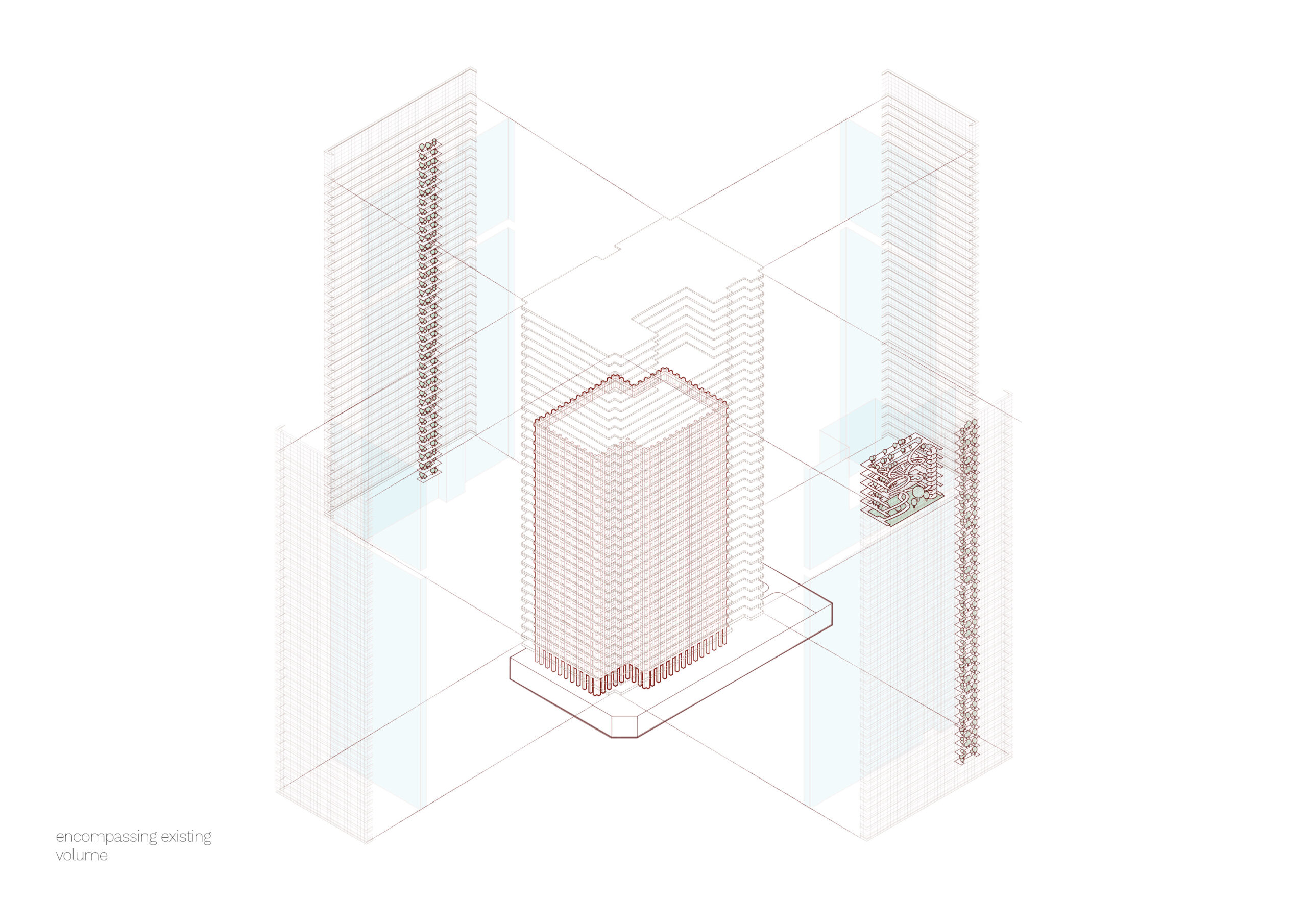
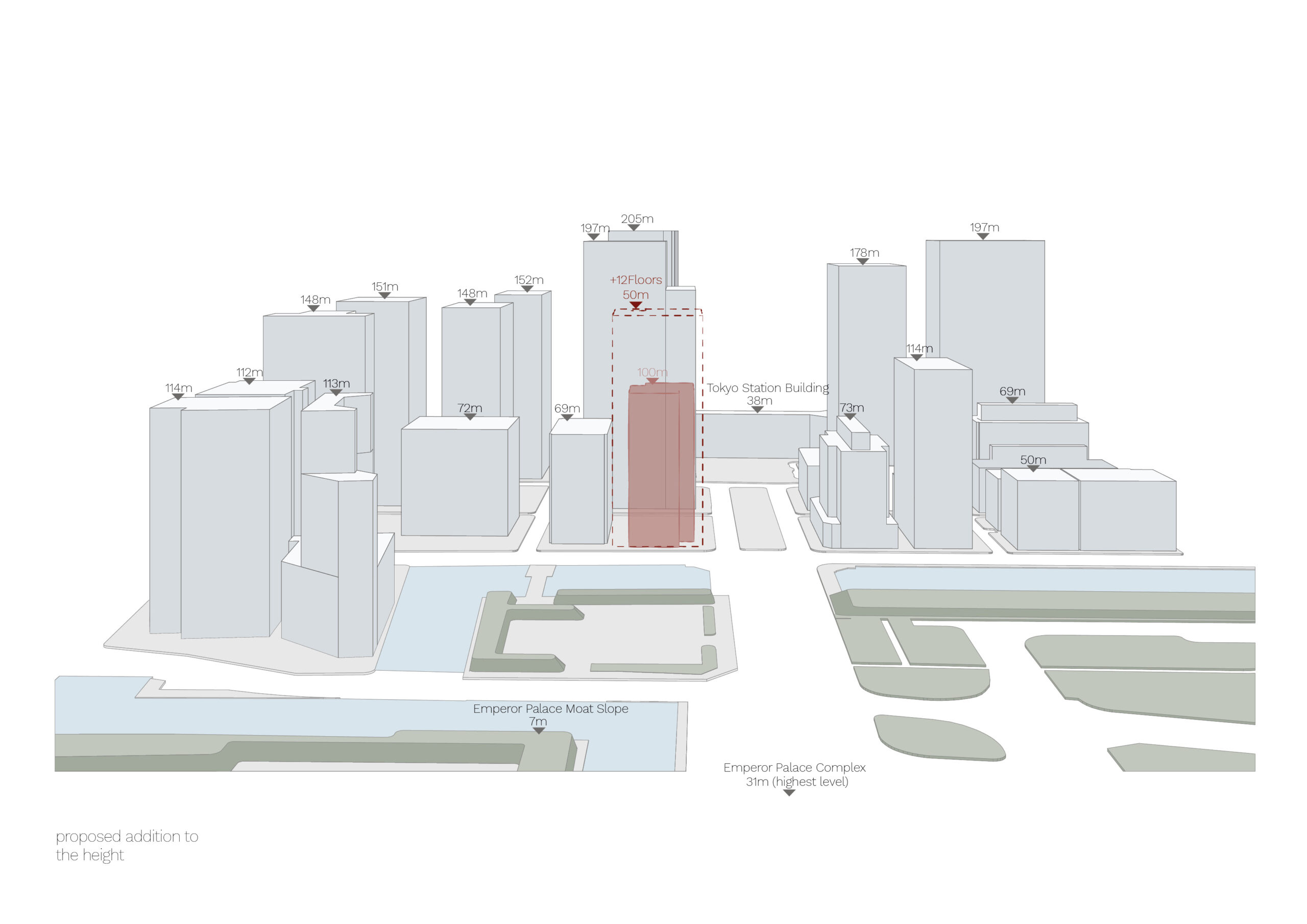
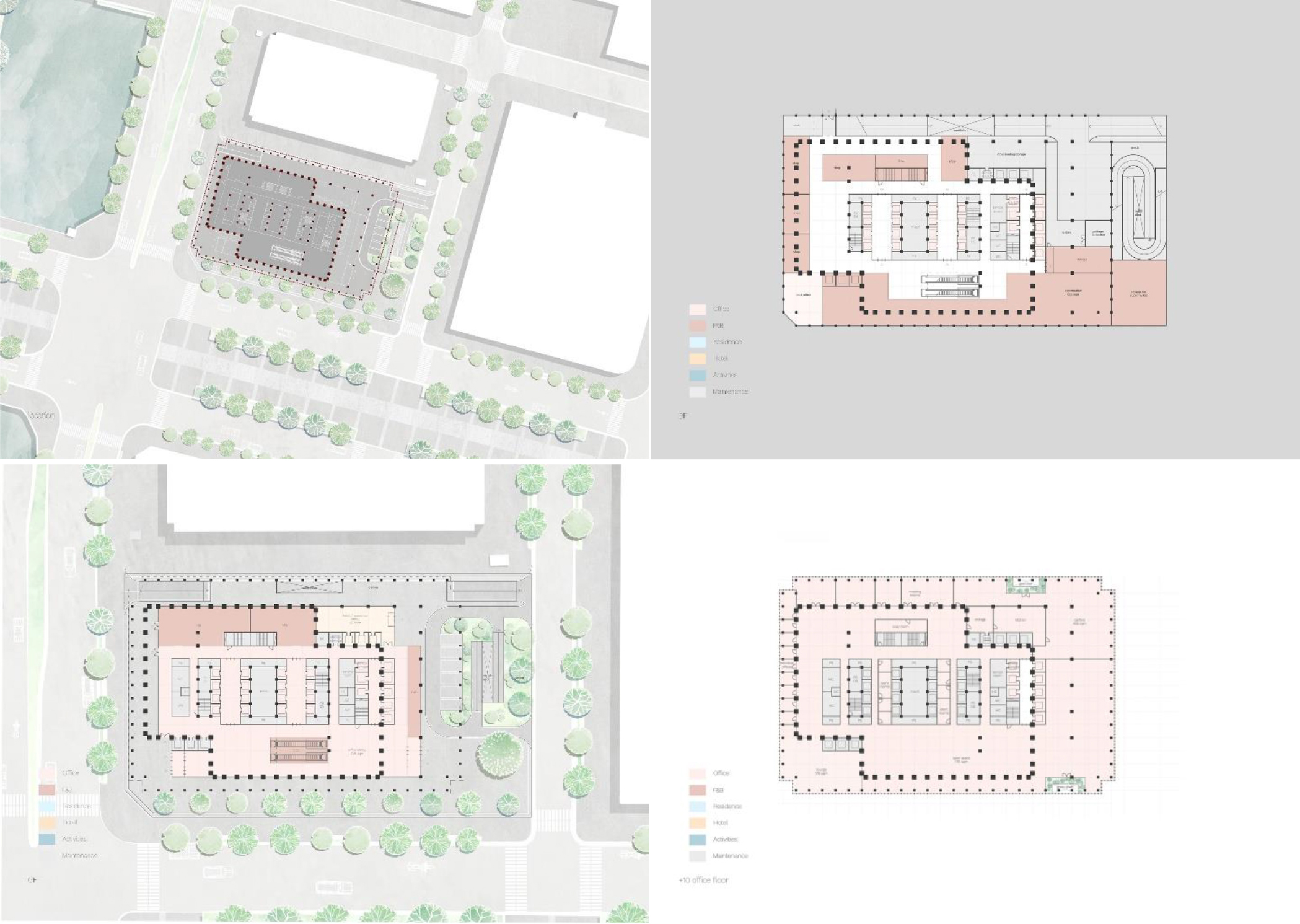
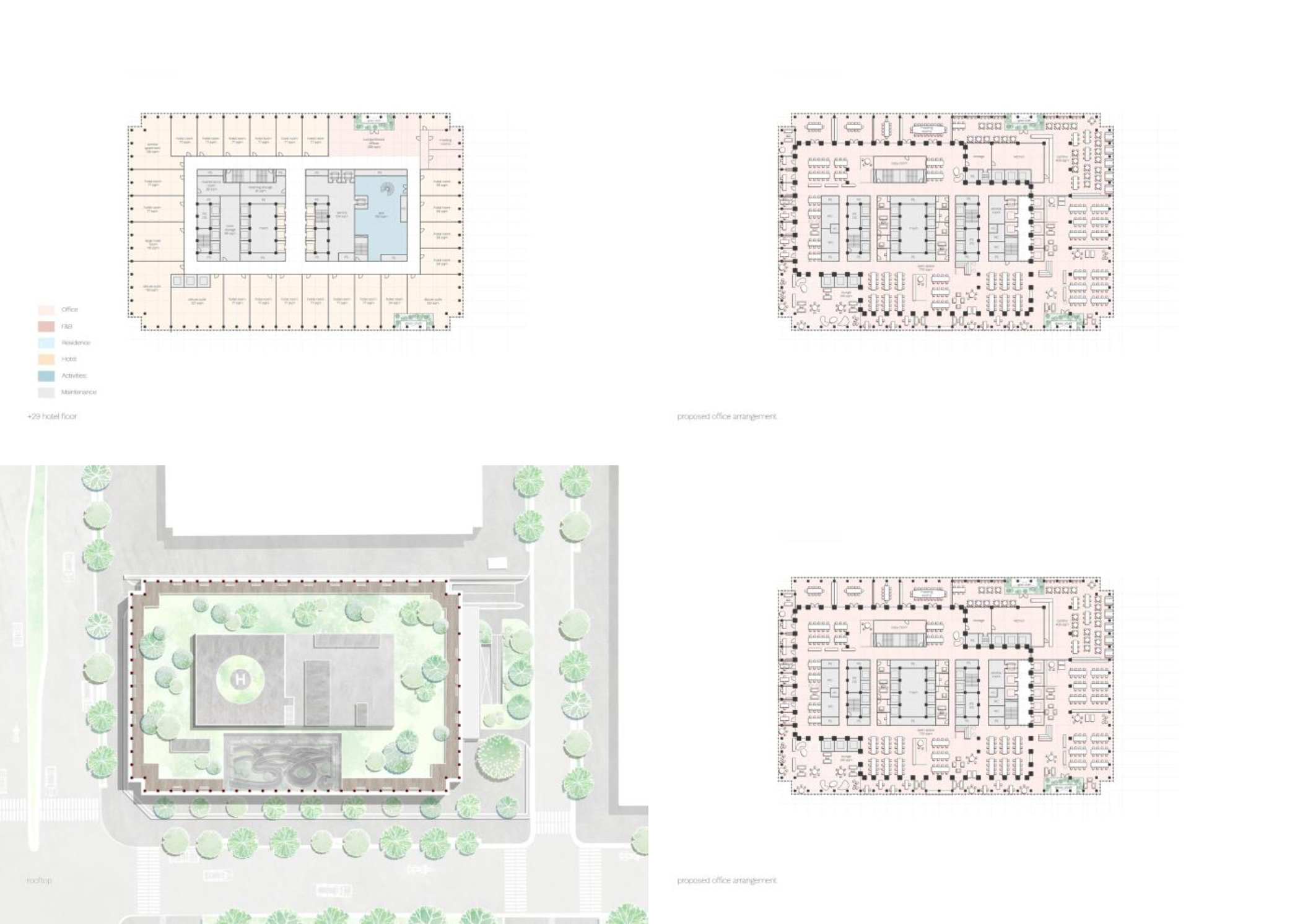
View Detail


